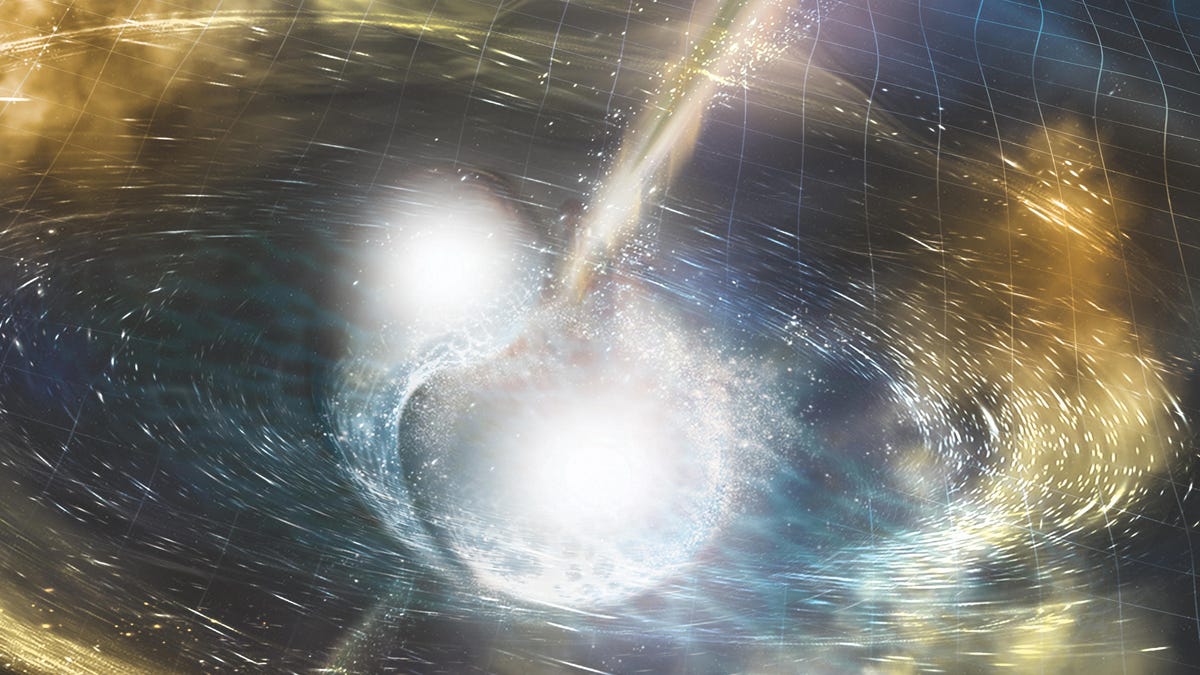Fierce neutron star collision shows how fast the universe is expanding
This cosmic explosion rippled through space-time. Finding more like it could solve mysteries such as the reason behind the universe's expansion.

This illustration shows two neutron stars colliding, generating gravitational waves and a bright jet.
Gravitational waves are huge disturbances in the fabric of space-time, caused by immensely energetic astronomical events that ripple out across the universe. Although first predicted by physicist Albert Einstein in 1916, we've only very recently been able to "see" them. And now researchers are turning to gravitational waves to help reveal some of the lingering mysteries of the universe.
One such mystery is the reason behind the universe's expansion. If you look at galaxies from the Earth, in any direction, you'll find that they all seem to be moving away from us. Scientists aren't sure exactly why this is -- they suspect it has something to do with dark matter or dark energy -- but they have been doing their best to measure how fast the universe is expanding. That measurement is known as the Hubble constant and is one of the most important values for us to truly understand what's happening across the universe.
Right now, researchers have two ways to estimate the Hubble constant: They can study the background radiation leftover since the Big Bang or they can study huge stars ("Type 1a supernova") blowing up in the distant universe. As it stands, the Hubble constant they get using the two methods is vastly different.
That's where gravitational waves come in. Studying the waves opens up a third way to estimate the Hubble constant.
This simulation shows two neutron stars colliding as gravitational waves spill outward.
In a paper published Monday in the journal Nature, an international team of astronomers used gravitational waves, generated by a merger of two incredibly dense neutron stars, to refine the measurement of the Hubble constant. The neutron star merger was first picked up in 2017 by gravitational wave detection efforts on Earth, known as LIGO and Virgo, and is designated GW170817.
Fortunately, the merger was also noticed by a gamma-ray detector and optical astronomy facilities, giving the star-gazing scientists more than one pair of specialized eyes on the event.
The gravitational waves generated by the event helped astronomers estimate how bright the merger should be. They then looked at how bright the merger actually was and worked out the distance -- allowing the constant to be estimated.
A collaboration of astronomers looked at GW170817 and used this method to determine the Hubble constant in 2017, but the new research used high-resolution radio data to assess a huge jet of energy that bolted out of the merger. That allowed the team to paint a more accurate picture of how the neutron stars were oriented in 3D space than previous studies, using models generated on supercomputers.
"Several groups have made this calculation using the GW170817 data, but we were able to do it more accurately because the radio data provided the inclination (of the merger) more accurately, which otherwise is a source of uncertainty in the calculation of the gravitational wave brightness," says Adam Deller, an astrophysicist at the Swinburne University of Technology in Australia and co-author of the article.
For the numbers nerds: Previous measurements using GW170817 estimated the universe was expanding at around 74 kilometers per second per megaparsec. The new study puts it around 70 kilometers per second per megaparsec. But that doesn't mean the universe is expanding slower than we believed.
"The uncertainty on our measurement is still large enough, from just this one event, that it remains consistent with both of the other two current leading methods for estimating the Hubble constant," says Deller. That means there's still work to do.
In October, two astronomers published a paper in Nature suggesting that if we could detect just 25 neutron star collisions, we could probably nail down the Hubble constant to within an accuracy of 3%. If that number increased to 200, the accuracy would be narrowed further to around 1%. However, the new research suggests around 15 more measurements of events like GW170817 would be enough to resolve the debate about the Hubble constant and the huge disparity seen in the two current methods.
That data could point us toward answers to even bigger questions about the universe.
"The Hubble constant is one of the fundamental cosmology constants that determine where the universe has been and where it is going," says Deller.
"Knowledge of it helps us interpret observational data and get a better handle on what the properties of dark energy and dark matter are -- and ultimately, hopefully, what they are."

